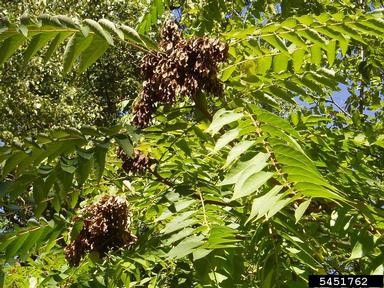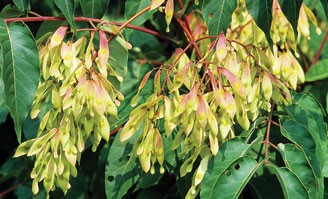Ailanthus altissima
Tree-of-Heaven
Synonyms: Ailanthus glandulosa; Ailanthus japonica; Albonia peregrine; Choerospondias auriculata; Rhus cacodendron; Toxicodendron altissimum
Class: Magnoliopsida
Order: Sapindales
Family: Simaroubaceae


Photographer: Leslie J. Menhoff, University of Connecticut Photographer: Bill Johnson
Source: http://www.invasive.org/ Source: http://www.nps.gov/
Description
The Tree-of-Heaven Ailanthus altissima, is a deciduous tree that can reach up to 70 feet in height. The twigs are chestnut-brown with smooth bark and branches are light to dark grey, smooth and glossy with raised dots. Plants are either male or female (dioecious) with soft wood that is weak and coarsely-grained. Leaves are large and compound with 11-25 leaflets; and can run up to 4 feet long. Flowers, fruits and seeds are large showy clusters and are usually yellow-green with hits of red (pictured right). Leaves, stems and some flowers have an offensive odor that sometimes smells like cat urine or rotting peanuts/cashews; because of this it is sometimes called the Stinktree.
Ecological Threat: Ailanthus altissima has adapted to urban areas and causes damage to sewers and structures; and poses a greater threat to agriculture and natural ecosystems. This tree grows very fast and is a prolific seeder that establishes dense stands that push out natives. Tree of heaven contains chemicals, including ailanthone, that have been found to have strong allelopathic (herbicidal) effects on the growth of other plants which help it establish and spread. With the herbicidal effects the tree-of-heaven is able to kill surrounding native plants and take over completely.
Biology: Since this tree is a dioecious species, male and female flowers are on different trees from April to June. Male trees produces three to four times more flowers than are usually found on female trees. The strong odor the flower emit attracts insects for pollination between the sexes. Also, this tree is able to grow by vigorous re-sprouting, especially in response to injury such as breakage or cutting.
History: The tree-of-heaven came to United States in 1748 by a Pennsylvania gardener as an ornamental plant. By 1840 it was made commercially available. It was introduced to California during the gold rushes of the mid-1800s, by the Chinese immigrants because of the tree’s medicinal and cultural importance. It was then first planted in Hawaii in 1924. Since the multiple points of introduction this tree has spread to 44 states, completely taking over native plants.
U.S. Habitat: It is highly adaptable to a range of soil types and conditions; it grows best in full sun, it is drought-tolerant and common in urban areas.
Distribution
Native Origin: China
U.S. Present: All states except: AK, MN, MT, ND, SD and WY
Resembles/Alternatives
This tree resembles several native species and genera: Staghorn sumac (Rhus typhina), Ash trees (Fraxinus sp.), Black walnut (Juglans nigra) and hickory (Carya sp.).
However the differences are: sumac has fuzzy, reddish-brown stems; ash species have opposite leaves; black walnut, hickory and sumac leaf margins are almost completely toothed and black walnuts have large green fruits.
Management
Do not plant and before trying to control, make sure that it isn’t any of the native species like staghorn sumac, ash or walnut. Large trees can be treated with stem injections of herbicides. For cut trees, applying the herbicides to the stumps prevents re-growth. Saplings can be treated with mineral oil and diesel fuel. Seedlings can be treated by directly applied the herbicide to all leaves on the plant.
Targeting large female trees for control will help reduce spread by seed. Because vegetative spread by male and female trees will continue to be a threat, elimination of all trees must be the long term goal. Systemic herbicides with active ingredients like glyphosate are most effective and can be applied to bark, cut stems or foliage.
References
Davies, P. A. 1944. The root system of Ailanthus altissima. Transactions of the Kentucky Academy of Sciences 1 1(34):33-35.
Fryer, J.L. 2010. Ailanthus altissima. In: Fire Effects Information System. U.S. Department of Agriculture, Forest Service, Rocky Mountain Research Station, Fire Sciences Laboratory.
Woodward, Susan L., and Joyce Ann. Quinn. 2011. Tree of Heaven. Encyclopedia of Invasive Species: From Africanized Honey Bees to Zebra Mussels. Santa Barbara, CA: Greenwood. 585-588. Print.
Zasada, John C.; Little, Silas. 2008. Ailanthus altissima (P. Mill.) Swingle: ailanthus. In: Bonner, Franklin T., Karrfalt, Robert P., eds. Woody plant seed manual. Agric. Handbook No. 727. Washington, DC: U.S. Department of Agriculture, Forest Service: 224-226.
Internet Sources
http://www.nps.gov/plants/alien/pubs/midatlantic/aial.htm
http://www.na.fs.fed.us/spfo/pubs/silvics_manual/volume_2/ailanthus/altissima.htm
http://wiki.bugwood.org/Archive:IPSF/Ailanthus_altissima
 Texas Invasive Species Institute
Texas Invasive Species Institute